Aruba is a jewel in the Caribbean and a tropical paradise. With strong indigenous roots, significant Spanish influence and a Dutch colonial era, Aruba has a rich and diverse past. These cultures have come together to create the harmonious melting pot that the island is today. Aruba is undoubtedly famous as a beach destination with its endless stretches of soft white sand and crystal-clear aquamarine water. Add the fact that the island has the highest number of sunny days in the Caribbean, and you’ll find plenty of outdoorsy things to do in Aruba, a postcard-perfect place.
People flock to the island for its stunning beaches (rightfully so) but soon find that Aruba has much more to offer. Between tropical bliss on the southwest coast and the rugged, wild northeast coast is an arid cactus-filled desert. Hiking trails, natural bridges, caves and historical sites are accompanied by thriving plant and animal species endemic to the island. Aruba may be a tiny island but there are opportunities for adventure and exploration and is home to some of the most friendly and welcoming people you will ever meet. It’s no wonder Aruba is called One Happy Island.
Contents
- Aruba
- Top Tours
- 20 Things To Do In Aruba
- 1- Go Beach-Hopping
- 2- Snorkel At Malmok Beach
- 3- Visit The California Lighthouse
- 4- Wander The Ruins Of A Gold Mine
- 5- Snap A Photo With The Famous Fofoti Trees
- 6- Tour The Aruba Aloe Factory
- 7- Explore The Ayo And Casibari Rock Formations
- 8- See Aruba’s Natural Bridges
- 9- Float With Flamingos At Flamingo Beach
- 10- Have A Seafood Feast At Zeerover
- 11- Hike Arikok National Park
- 12- Enjoy Ancient Art At Fontein Cave
- 13- Visit The Donkey Sanctuary
- 14- Tour The Butterfly Farm
- 15- Watch The Kite Surfers At Grapefield Beach
- 16- Hike The Hooiberg Trail
- 17- See The Dutch Colonial Buildings By Tram
- 18- Visit The Royal Plaza Mall
- 19- Relax At Baby Beach
- 20- Explore The Spanish Lagoon
Aruba
Top Tours
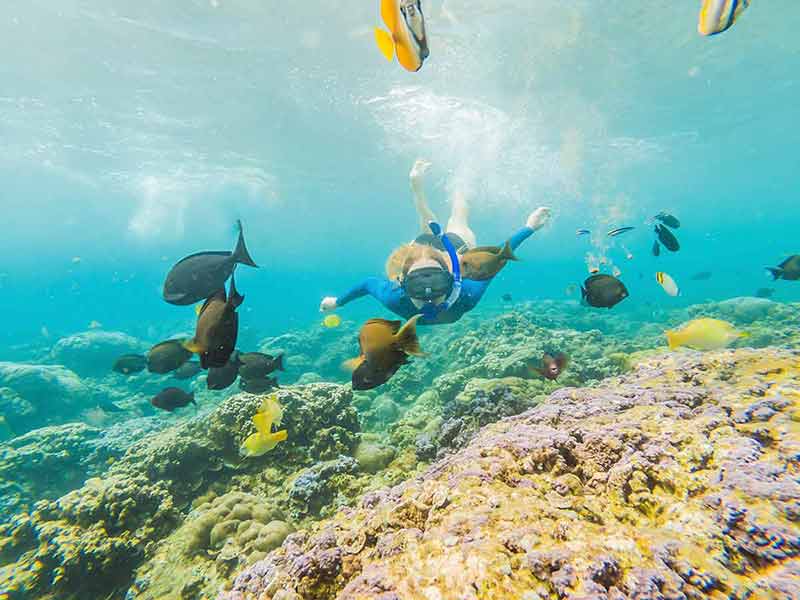
- Aruba Catamaran Sail – with snorkelling aboard the Arusun catamaran.
- Snorkelling Cruise – aboard the Dolphin with two snorkel stops, open bar and a light lunch.
- Aruba Champagne Breakfast and Lunch Cruise – with free flowing champagne and croissants. Discover islands and live the high life; snorkelling included.
20 Things To Do In Aruba
1- Go Beach-Hopping
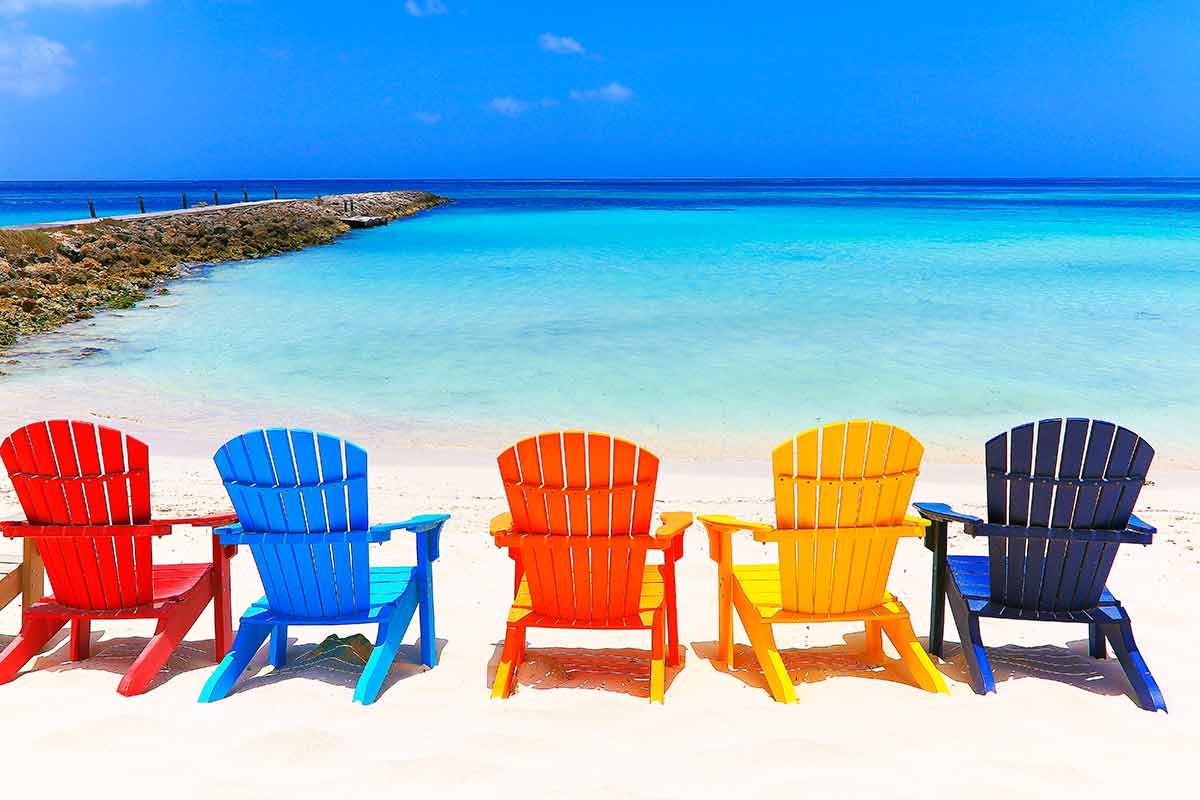
Aruba’s stunning beaches are some of the best in the Caribbean and any trip to the island will undoubtedly include an abundance of pure beach bliss.
Most of Aruba’s best beaches lie along the northwest coast and it’s possible to walk a stretch of 6.2 miles (10 km) almost entirely uninterrupted, beach to beach.
Hopping from Arashi Beach at the top to Druif Beach just before Oranjestad is the paradisical pilgrimage I carved out almost every day, during my time in Aruba.
This route covers nine beaches, each with its own unique charm, just as stunning as the last.
Whether you’re getting around by car, public transport or on foot like me, it’s easy to beach-hop in Aruba and discover what each one has to offer.
Recommended tours:
- Aruba Full-Island Tour
- Aruba Atlantis Submarine Expedition
- Natural Pool Horseback Riding Tour in Aruba
2- Snorkel At Malmok Beach
Malmok Beach is on the island’s northwest side and is not the typical sandy beach you would expect.
It is mostly porous rock with a few little coves leading to the water, however, the rocky terrain makes Malmok Beach a prime spot for incredible snorkelling.
The sea bottom is soft, silky sand with clusters of coral and tufts of seagrass that turtles feed on. But the rocky edge is where the magic happens.
The water eroded the rock creating an overhang and underneath it is teeming with spectacular, colourful sea life.
Malmok Beach is off the main tourist path, making it much less crowded.
I had the whole spot to myself until I ducked my head under the water and became part of a bustling metropolis of sea life.
Recommended tours:
- Snorkeling with Solar Power Sea Scooters – Group Tour
- Aruba 2-Tank Dives Certified Divers Experience
3- Visit The California Lighthouse
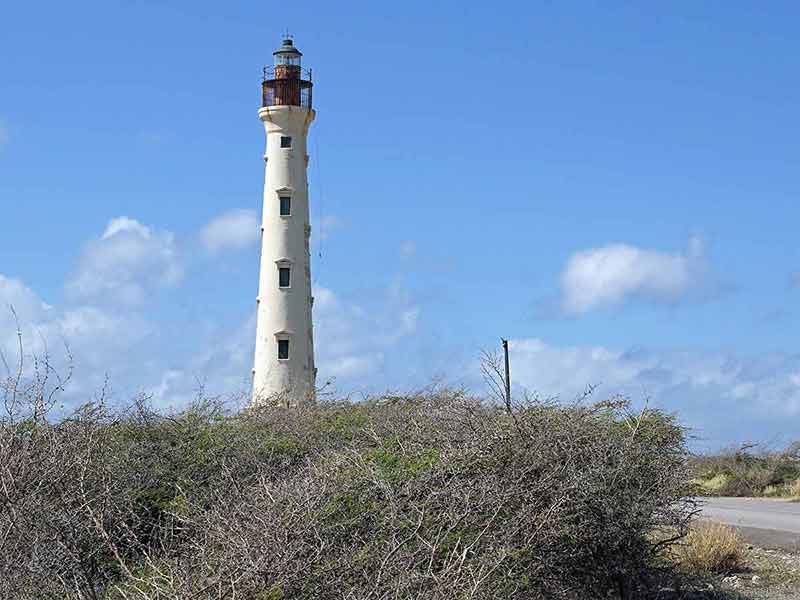
Aruba’s northern tip has a unique and rugged desert landscape and a great way to explore it is with a bird’s eye view.
The California Lighthouse was built in 1915 and was named after the S.S. California which sunk not long before its construction.
The California Lighthouse sits on a limestone plateau and is the tallest structure on the island, making it the highest viewpoint.
You can climb to the top and take in a picture-perfect panoramic view of the northern tip and surrounding beaches.
From the lighthouse, you have easy access to the Arashi Dunes.
The dunes are a sandy, moon-like landscape with trails leading to Westpunt Boca, the island’s northernmost point.
Westpunt is a spectacular spot to watch the sea crashing into the underlying cave and to catch a stunning sunset.
The California Lighthouse is at Hudishibana 2, Noord, Aruba.
Recommended tour:
4- Wander The Ruins Of A Gold Mine
Aruba’s rugged northeast coast was once home to a bustling gold mining industry.
The Bushiribana Gold Mill was constructed in 1874 during the island’s gold rush.
The mill was powered by the strong winds gusting from the northeast sea, grinding the rocks to dust and leaving behind chunks of gold.
Burshiribana Gold Mill operated on and off until 1899 when production was permanently halted due to low profits and high cost of operation.
Nearby, the newly built Balashi Mill had better train connections and improved processing techniques.
Today, the ruins of the gold mill still stand against the wild and barren coast.
You can explore the old stone walls, climb the original staircase and learn more about Aruba’s historic gold rush.
The Bushiribana Ruins is at H23F+C9F, Noord, Aruba.
5- Snap A Photo With The Famous Fofoti Trees
The Fofoti Trees on Eagle Beach are undeniably the most iconic landmarks on the island.
Aruba is well known for its Fofoti trees and their unique shape.
These trees are often called natural compasses because they point southwesterly due to the trade winds blowing across the island.
The Fofoti tree is a powerful symbol of resilience and determination on the island, as it survives on salt water and stays firmly rooted in the sand.
Eagle Beach is one of the best beaches in the world.
It’s the most wide and spacious beach in Aruba, with fluffy white sand and crystal-clear turquoise water.
With the Fofoti trees rooted on this beautiful beach, it’s no wonder they are the most photographed landmark in Aruba.
The Fofoti Trees are at HW3V+RX7, Noord, Aruba.
6- Tour The Aruba Aloe Factory
Aloe is one of Aruba’s main exports and played an important role in Aruba’s agricultural history.
The island’s arid desert-like climate creates the perfect conditions for the aloe plant to thrive.
Aruba’s aloe is considered the finest quality in the world, jam-packed with potent vitamins and minerals.
The Aruba Aloe Factory was founded in 1890 and is one of the oldest Aloe companies in the world, still very much active today.
A tour of the Aruba Aloe Factory will lead you to the aloe fields to see how the plant is harvested.
Inside the factory you can visit the aloe-cutting room, the testing lab and see where aloe products are packaged and stored.
Along the way, you will learn about aloe’s many health benefits and the history of aloe in Aruba.
Best of all, a tour of The Aruba Aloe Factory is completely free of charge.
The Aruba Aloe Factory is at Pitastraat 115, Aruba.
7- Explore The Ayo And Casibari Rock Formations
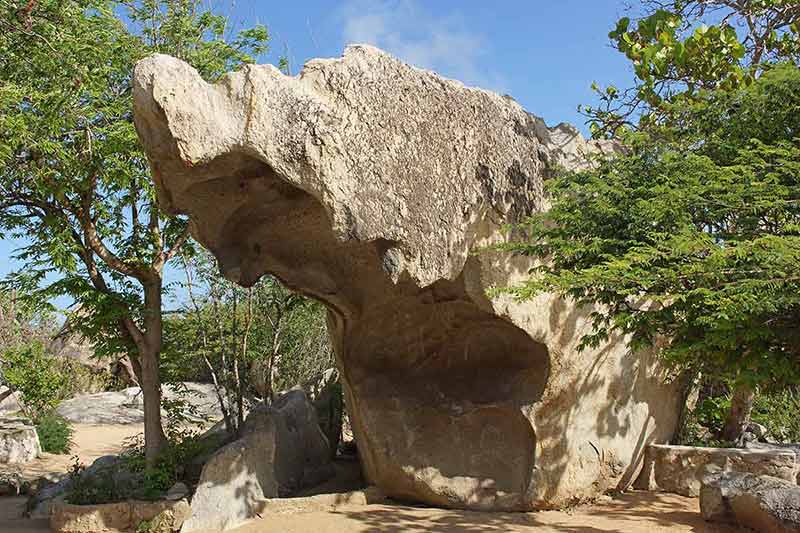
Aruba is a relatively flat island, so coming across clusters of monolithic boulders is quite an unusual site.
It is still a mystery how these boulders came to be and why they are grouped in such a way.
Their presence is connected to the Arawak people (the island’s earliest settlers), who arrived in 2000 BC.
The Ayo and Casibari Rock Formations are just 2.2 miles (3.5 km) apart.
Both sites offer walking paths around and through the mysterious boulders.
The Ayo rocks have an elevation of 175 feet (53 m), while Casibari stands at 140 feet (42.5 m).
Climb to the top and take in amazing panoramic views of the island.
What’s unique about The Ayo Formations are the ancient petroglyphs left on the rocks by the Arawak people.
These ancient painted carvings date back thousands of years and the site is said to have been used for indigenous ceremonies.
The Ayo Rock Formations are at G2JH+GP Santa Cruz, Aruba.
The Casibari Rock Formations are at G2J3+8CQ, Paradera, Aruba.
8- See Aruba’s Natural Bridges
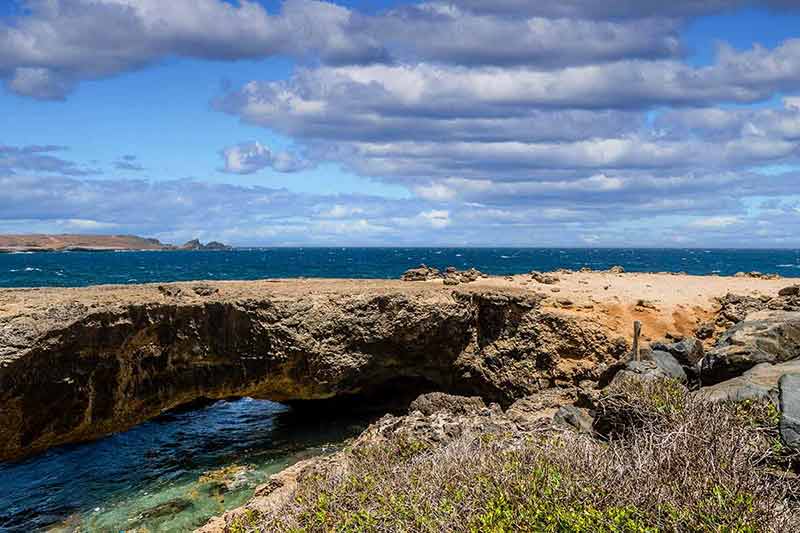
Aruba’s northeast coast is wild and rugged, with strong winds and waves crashing into the limestone shoreline.
Over time these conditions have shaped the coast, creating stunning features like natural bridges.
The Tripod Bridge in Aruba’s Andicuri Bay is truly a spectacular site.
The bridge is named after its three legs which are connected to a central pillar, giving it a tripod shape.
The legs are sturdy enough to walk along and enjoy the view from the middle.
The Tripod Bridge is particularly impressive at sunrise.
Sadly, the island’s most impressive natural bridge collapsed many years ago.
It was 25 feet (7.6 m) high and 100 feet (30 m) long and its remains are still a popular attraction.
Unless you have a 4×4 vehicle, it is recommended to park at this natural bridge (simply called Aruba’s Natural Bridge) and hike 15 minutes to the Tripod Bridge.
The Tripod Bridge is at G2QX+5P7, Santa Cruz, Aruba.
Aruba’s Natural Bridge is at G2RR+9Q Santa Cruz, Aruba.
Recommended tour: Island Ultimate Jeep Safari in Aruba Natural Bridge
9- Float With Flamingos At Flamingo Beach
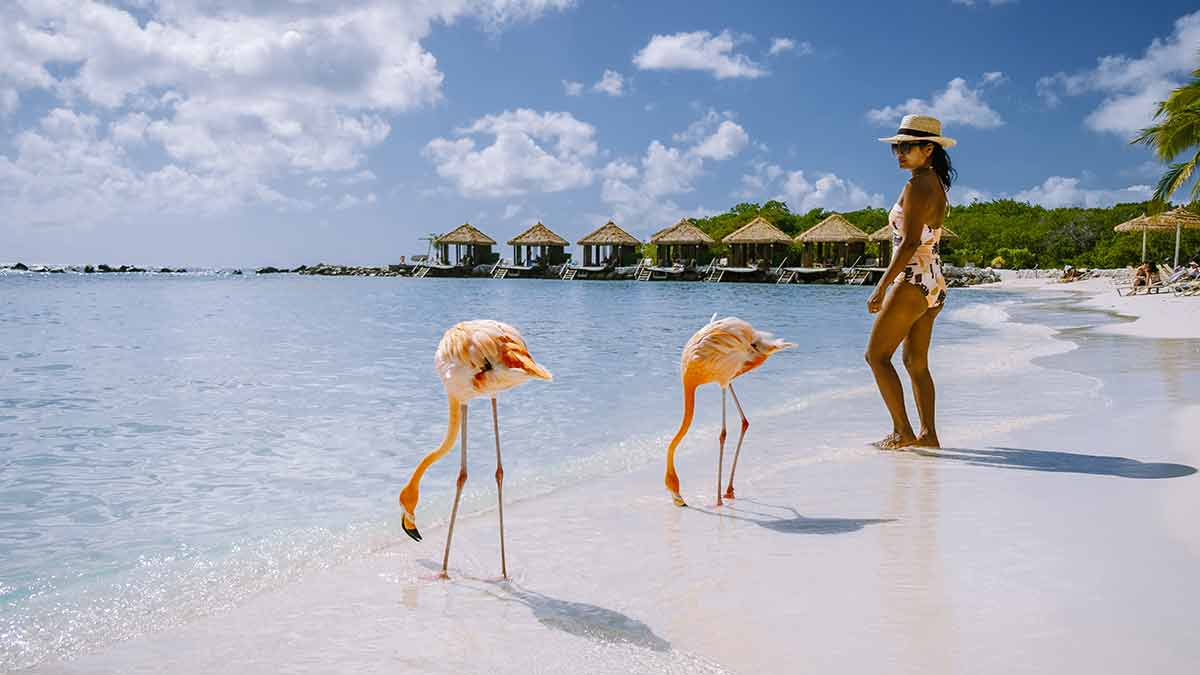
The one and only spot in Aruba to see flamingos is at the aptly named Flamingo Beach on Renaissance Island.
Renaissance Island is a private island with a dense mangrove and Aruba’s only private beaches, Flamingo Beach and Iguana Beach.
This attraction takes a bit of planning ahead.
You’ll need a day pass to access the island, but it’s worth it to spend the day lounging on a beach with flamingos.
The beach is beautifully calm, crystal-clear and not crowded at all.
It’s the perfect spot for optimal beach lounging and flamingo-watching.
The flamingos rule the roost and wander freely wherever they please.
If they are in a social mood, you will have plenty of opportunities to snap photos with them.
You can feed them with nibbles from the flamingo food dispenser.
It’s a once-in-a-lifetime experience.
Flamingo Beach is at GX2C+C6 Oranjestad, Aruba.
10- Have A Seafood Feast At Zeerover
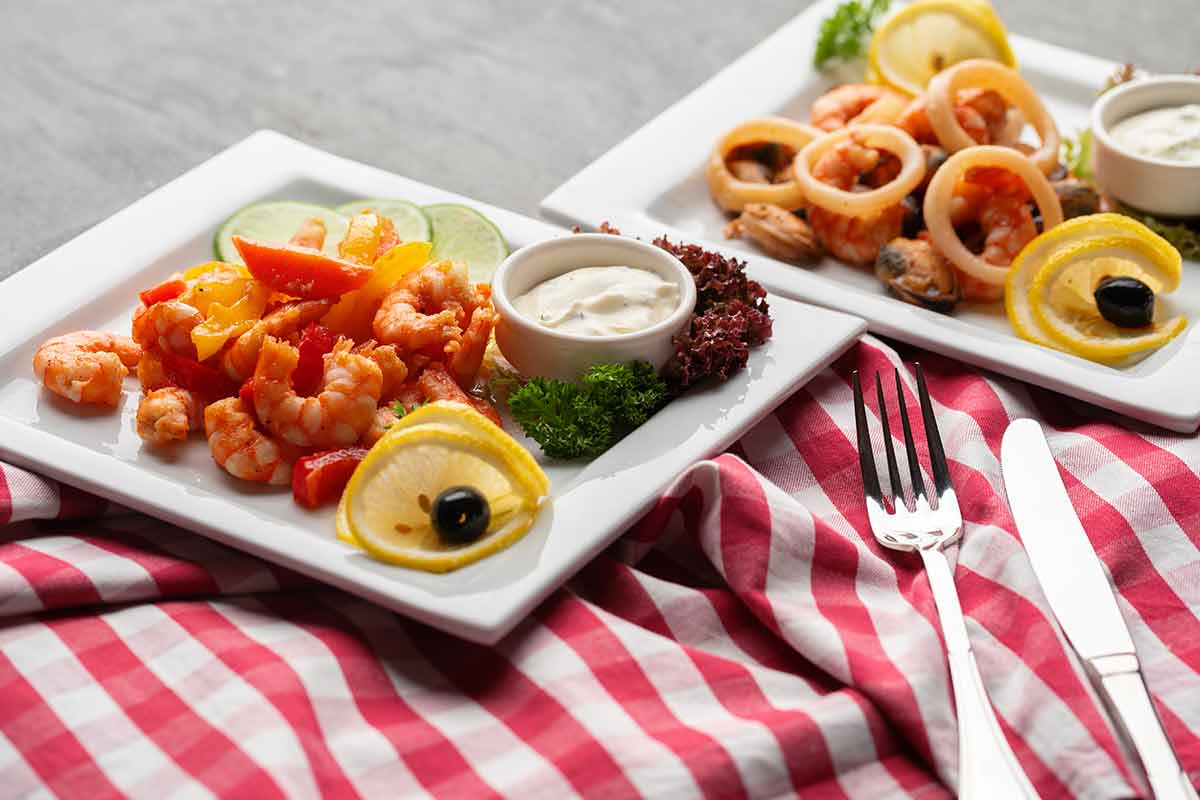
Ask a local Aruban where’s a great place to eat, they will happily tell you about Zeerover and as it’s well-loved by locals, you know the food will be delicious.
Zeerover provides a true Aruban experience, right next to the village of Savaneta, the country’s former capital.
They serve the freshest fare you can get and the menu changes depending on the catch of the day.
Don’t be alarmed if you don’t see a menu at all.
All you have to do is walk up to a booth where you will be asked how much fish you would like.
One guarantee is that it will be the freshest fish you’ve ever had.
By the time you get a refreshing drink at the bar and settle in at your table, your perfectly cooked meal will be served.
The seafood comes with an array of delectable local sides like fried plantain and pan bati (cornbread).
This is not just a meal but an entire experience.
One not to be missed while in Aruba.
Zeerover is at Savaneta 270, Savaneta, Aruba.
Recommended tour: California Lighthouse Dining Experience in Aruba
11- Hike Arikok National Park
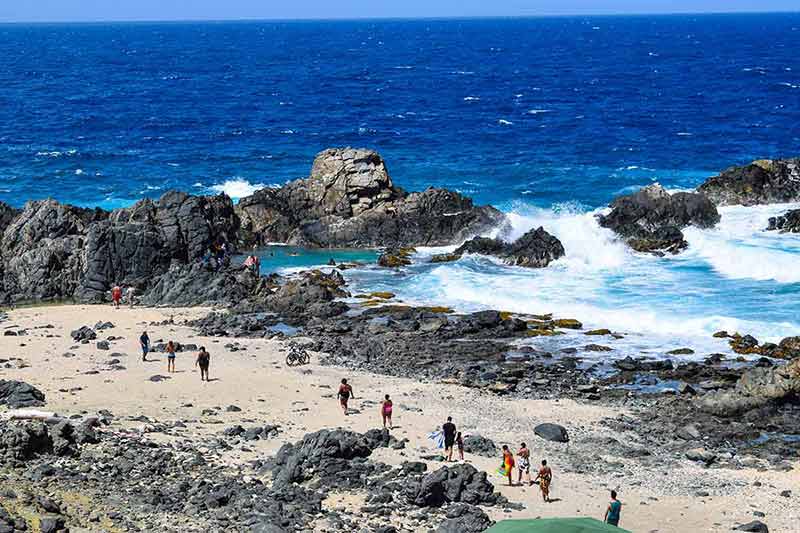
Arikok National Park covers nearly 20% of the island and contains several hiking trails, from easy to challenging.
Each one leads you through areas of unique geological and historical sites.
The park is home to a plethora of protected flora and fauna that can only be found in Aruba.
You can find tall, thin cacti, tiny fruit-bearing barrel cacti and all shapes and sizes in between.
If you’re lucky, you might even be able to spot Aruba’s cat-eyed snake, whiptail lizard or burrowing owl.
The rock outcrops create micro-climates that help these plants and animals thrive in desert-like conditions.
Historic sites inside the park include some of Aruba’s oldest paintings left by the Arawak people on massive boulders dotted throughout.
The more challenging trails will take you up Aruba’s tallest hills, Arikok Mountain stands at 610 feet (186 m) and Jamanota Hill has an elevation of 616 feet (188 m).
The most challenging part about climbing these peaks is the heat. The views from the top make it worth every step.
Arikok National Park is at San Fuego 70, Santa Cruz, Aruba.
Recommended tours:
12- Enjoy Ancient Art At Fontein Cave
Aruba’s Fontein Cave is brimming with colourful art, both natural and manmade.
The cave’s history can be traced back to nearly 4000 when the Amerindians discovered the caves.
They are said to have used the caves for shelter from storms, a hideout from enemies and for tribal rituals and ceremonies.
The Amerindians left their mark by way of intricate carvings and paintings that can be seen throughout the cave.
This limestone formation is lined with stalactites and stalagmites coated with algae, colouring the cave with vivid greens and yellows.
A colony of long-tailed bats call Fontein Cave home.
They nestle in the limestone nooks and crannies and feed on nectar and pollen at night.
The cave is also frequented by crabs and damp-dwelling insects.
Fontein Cave is at F3VV+54 Santa Cruz, Aruba.
13- Visit The Donkey Sanctuary
How would you like to make friends with Donkeys? At Aruba’s The Donkey Sanctuary, you can do just that.
Donkeys have been part of Aruban culture for hundreds of years, providing the island’s main mode of transportation.
Since the arrival of cars, these cuddly creatures were no longer of use.
In the 70s, a widespread illness nearly wiped out the donkey population.
They haven’t had the best of luck.
The Donkey Sanctuary was founded in 1997 and is a non-profit, volunteer-run organisation.
They provide a happy home and much-needed love and care to over 120 donkeys.
Visitors can spend time getting to know these friendly, affectionate creatures.
You can even bring them their favourite treats, apples and carrots.
There are also cats, chickens and peacocks freely roaming the sanctuary ready to make friends.
The Donkey Sanctuary is at Bringamosa 2-Z, Santa Cruz, Aruba.
14- Tour The Butterfly Farm
Imagine frolicking with hundreds of brightly coloured, fluttering butterflies among vibrant tropical trees and flowers.
One man had that very dream and brought it to life.
William Slayter opened the first Butterfly Farm in Saint Martin in 1994.
After a string of wild hurricanes, he decided to open another farm in the more stable climate of Aruba.
Aruba’s Butterfly Farm is home to exotic butterflies from every corner of the world.
Visitors can wander around a large mesh enclosure where the butterflies fly freely among the tropical foliage.
With the help of a guide, you can even learn how to handle the butterflies without harming their delicate wings.
Throughout the farm, you can see all the life cycle stages, from egg to caterpillar to chrysalis.
I recommend visiting in the morning when the butterflies are most active and you may even witness them emerging from their chrysalis.
The Butterfly Farm is at HW7X+FW4, J.E. Irausquin Blvd, Noord, Aruba.
15- Watch The Kite Surfers At Grapefield Beach
If you’re hunting for a day of solitude while in Aruba, Grapefield Beach is the perfect spot.
Located on the island’s southeast coast, this beach’s best feature is that there are no features at all, just pristine beach.
Views of the Vader Piet Wind Farm to the north and a few abandoned fishing shacks dotted along the shore are the only structures in sight.
The rest is a long stretch of nearly untouched beach with soft golden sand and tropical blue water lapping onto the shore.
Grapefield Beach is a kite surfer’s dream because of the trade winds gusting through this part of the island.
The thing to do is pack a picnic, bring a beach blanket and sprawl out on the sand to watch the surfers fly by.
It is not recommended to swim at Grapefield because of the wild currents, but you can wade in the water near the shore to cool off from the heat of the tropical sun.
Recommended: Private Kitesurfing Lesson in Aruba
16- Hike The Hooiberg Trail
With Aruba being a relatively flat island, it’s nearly impossible to miss the cone-shaped, volcano-like mountain rising 540 feet (164 m) from the middle of the island.
Hooiberg Mountain, also called Haystack Hill, is made up of quartz diorite that can only be found in Aruba.
The mountain also features the one-of-a-kind, windswept divi-divi trees that Aruba is famous for.
Hiking the Hooiberg Trail takes you along a 0.5-mile (0.8 km) path, including around 560 stairs leading to the summit of Hooiberg Mountain.
Reach the top and be rewarded with spectacular aerial views of Aruba.
You can even see the coast of Venezuela on a clear day.
The Hooiberg Trail is at G294+MJC, Oranjestad, Aruba.
17- See The Dutch Colonial Buildings By Tram
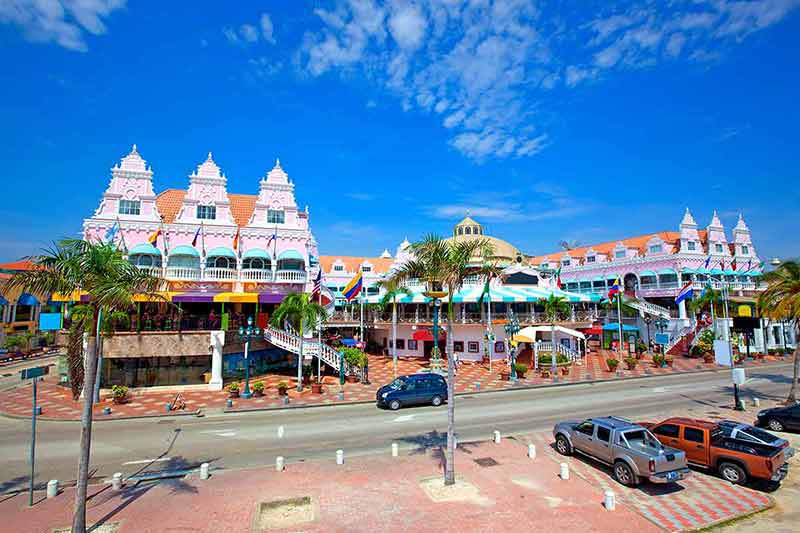
Getting to know downtown Oranjestad is easy with Aruba’s charming trams.
Starting near the cruise terminal, the tram takes you along a circuit through the main downtown area.
You can enjoy a leisurely ride through Oranjestad’s centre on either a single-deck or double-decker tram.
The route cruises past Aruba’s brightly coloured Dutch Colonials buildings.
These ornately decorated structures create an impressively delightful atmosphere.
The tram makes several stops next to museums, monuments, plazas and more.
The best part is that you can hop on and off as you please and it’s completely free of charge.
The Aruba Tram is at GXC5+FJ3, Oranjestad, Aruba.
Recommended tour: Aruba Downtown Historic and Cultural Walking Tour
18- Visit The Royal Plaza Mall
The Dutch-Caribbean architecture in downtown Oranjestan is impossible to miss.
The vibrant buildings that line the capital’s centre streets are a feast for the eyes.
The Royal Plaza Mall is the most impressive of them all. It looks like a giant, elaborately decorated wedding cake, complete with spiral staircases.
The open-air mall offers a variety of stores from high-end brands to local kiosks and a diverse array of restaurants and cafés.
Whether you are a shopping enthusiast or not, The Royal Plaza Mall is a sight you must see.
The Royal Plaza Mall is at Lloyd G. Smith Blvd 94, Oranjestad, Aruba.
Recommended tours:
- Aruba Happy Hour Tour
- Nightlife Barhopping Tour with DJ and Dancing on Party Bus in Aruba
- Aruba Dinner and Nightlife Tour
19- Relax At Baby Beach
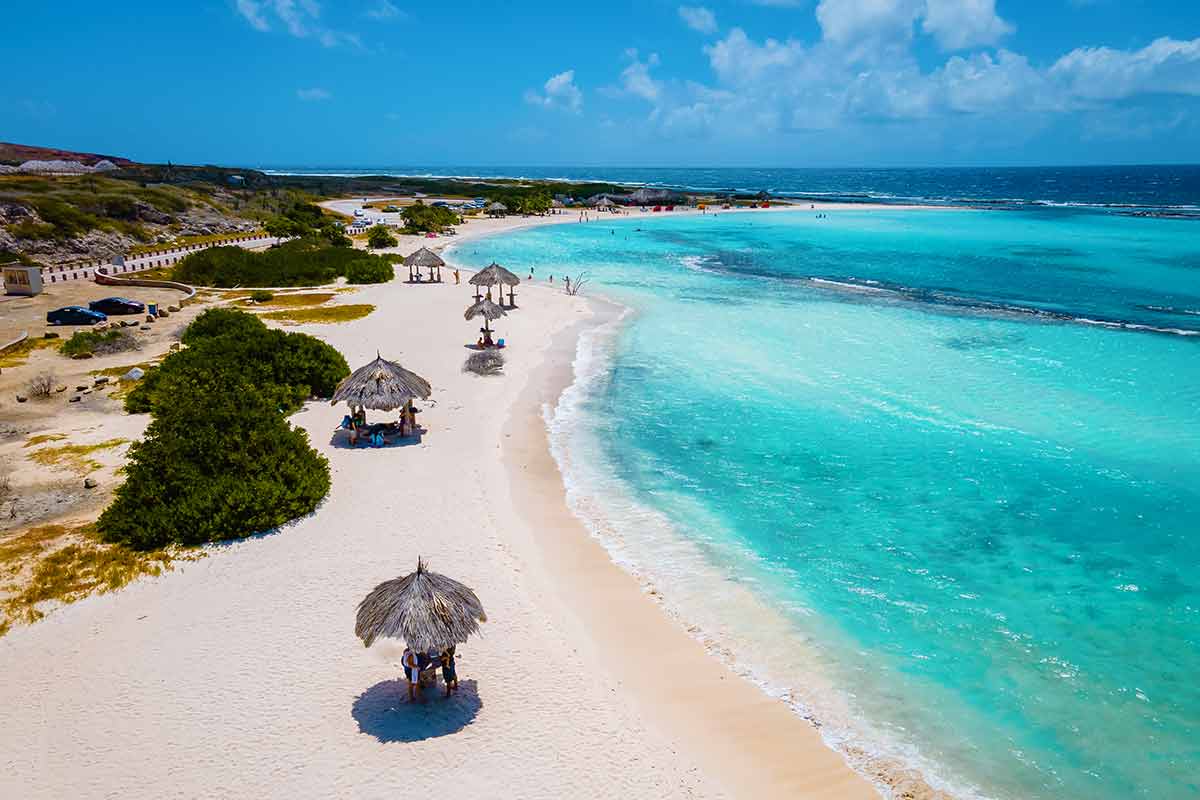
Baby Beach rests in a secluded bay on the southern tip of Aruba.
The coastline forms a nearly complete loop, resulting in a beach that resembles a lagoon.
The shallow, crystalline waters make it an ideal location for beach lovers who want to lounge lazily in the water without waves or currents.
You can wade out anywhere within the bay and still have your feet in the sandy sea bottom.
Baby Beach provides ultimate relaxation.
You’ll find beach huts dotted throughout for some much-needed shade.
There’s a restaurant and bathrooms on site.
Near the mouth of the bay is a small reef perfect for snorkelling while remaining inside the protected, calm beach.
Recommended tour:
20- Explore The Spanish Lagoon
There are 171 hectares of protected mangrove areas in Aruba, most of which grow on the southwestern coast and the reef islands.
Mangroves play an important role in helping fish and marine life thrive and they are home to many of the island’s bird species.
The Spanish Lagoon is just one of the protected areas where 190 animal species reside.
The lagoon can be enjoyed by strolling the trails around it or you can get an inside view and tour the waters with a kayak or stand-up paddleboard.
It’s a fantastic spot for bird-watching with frequent appearances of hummingbirds, herons and Aruban owls.
The Spanish Lagoon is at F2HH+M77, Oranjestad, Aruba.
Recommended tour:
Looking for a Caribbean vacation? Read:
- 20 Things To Do In San Juan
- 20 Puerto Rico Cities and Towns
- National Parks in Puerto Rico
- Best Time To Visit Puerto Rico
- 20 Landmarks in Puerto Rico
- 20 Things To Do In Jamaica
- 20 Jamaican Drinks
- 10 Villas in Jamaica
- My Jamaica Vacation
- Best Time To Visit Cuba
- 20 Landmarks in Cuba
- Carnaval de Santiago de Cuba
- 10 Things To Do In Cuba
- 20 Things To Do In The Bahamas
- 20 Things To Do In Aruba
- Where To Stay in Jamaica
- Where To Stay in the Bahamas
- 20 Things To Do In Dominica
- 20 Things To Do In Antigua
- 20 Things To Do In St Lucia
- 20 Things To Do In Grand Cayman
- 15 Overwater Bungalows In Jamaica
- 20 Beaches in Curacao
- 20 Beaches in Trinidad and Tobago
- 20 Beaches in Anguilla
- 20 Beaches in Grenada
- 20 Beaches in Aruba
- 20 Beaches in Cayman Islands
- 20 Beaches in Haiti
- 20 Beaches in Barbados
- 20 Beaches in Turks and Caicos
- 20 Beaches in Jamaica
- 20 Beaches in Dominican Republic
- 20 Beaches in Cuba
- 20 Things To Do In St Thomas (US Virgin Islands)
- 20 Things To Do In Trinidad and Tobago
- 20 US Virgin Islands Resorts
- 20 Things To Do In Grenada
- 20 Types of Caribbean Food
- 20 Things To Do In Turks And Caicos
- 20 Things To Do In Haiti
- 20 Things To Do In Dominican Republic
- Where To Spend Christmas In The Caribbean
Plan Your Trip

Rent A Car – Find the best car rental rates at Discover Cars. They compare car hire companies to provide you with the best deal right now.

Find A Hotel – If you’re curious about this article and are looking for somewhere to stay, take a look at these amazing hotels.

